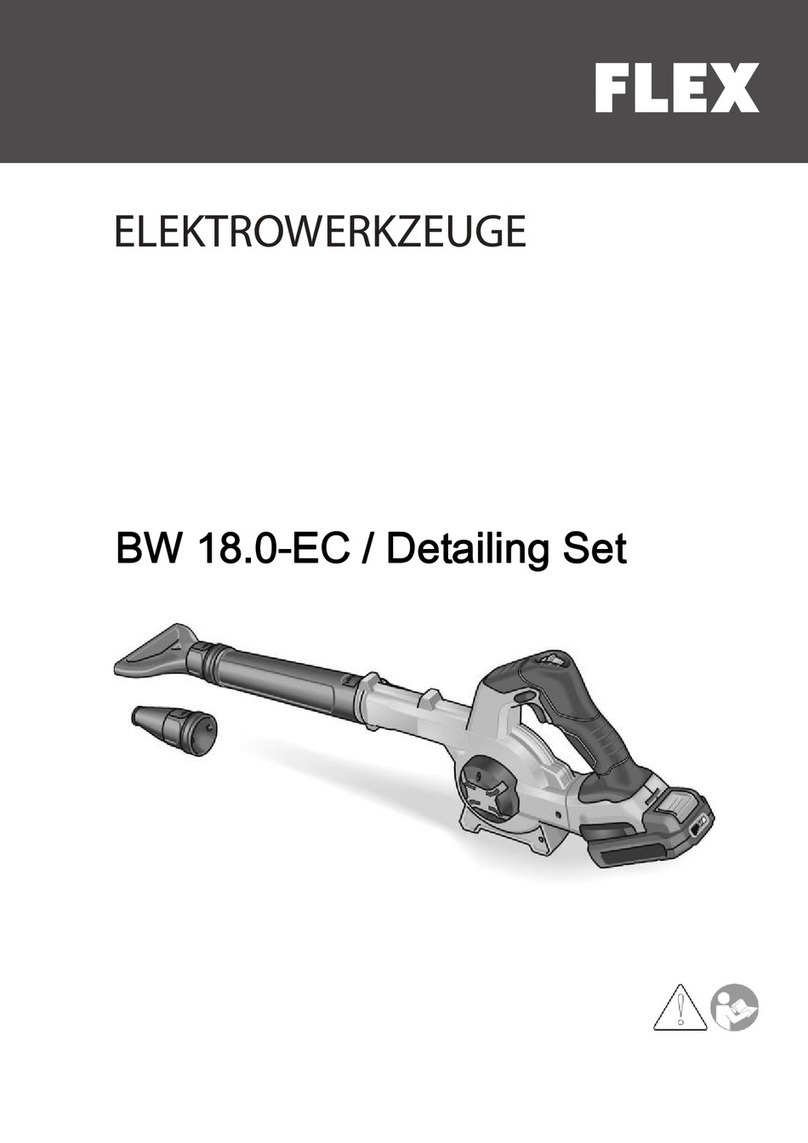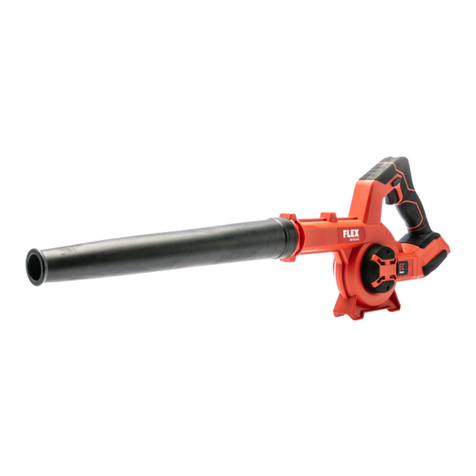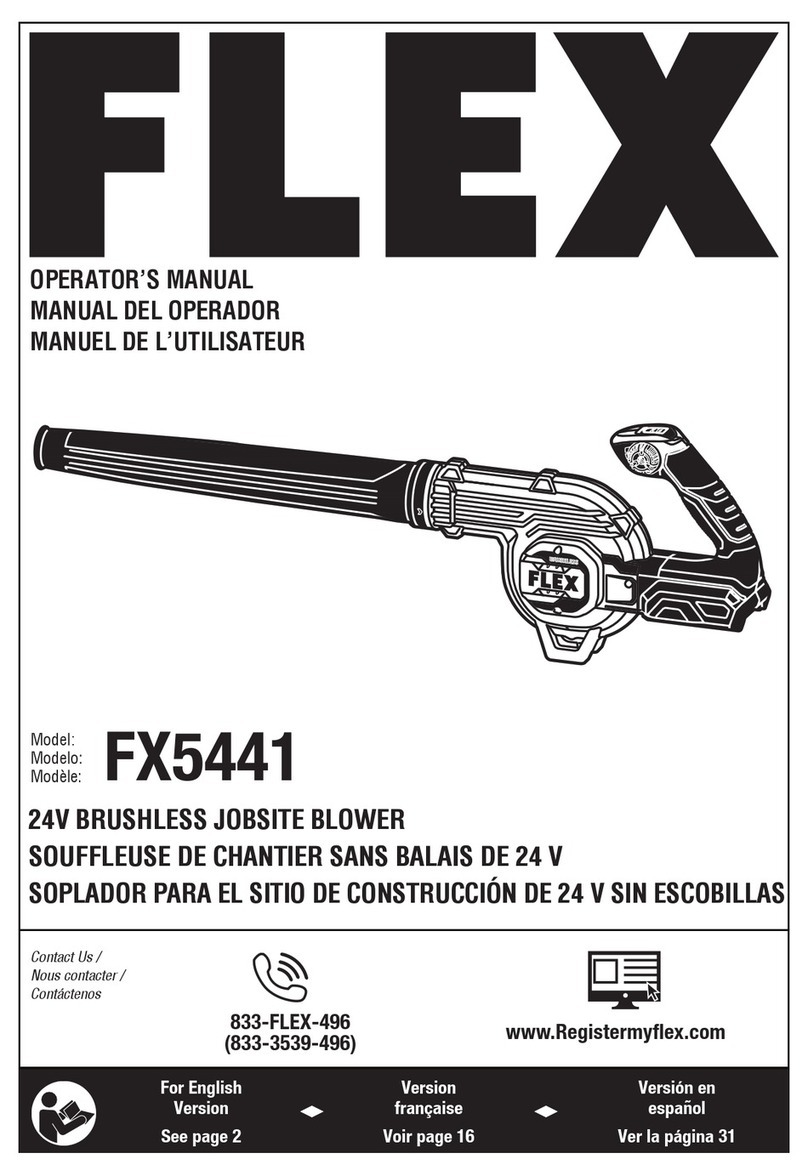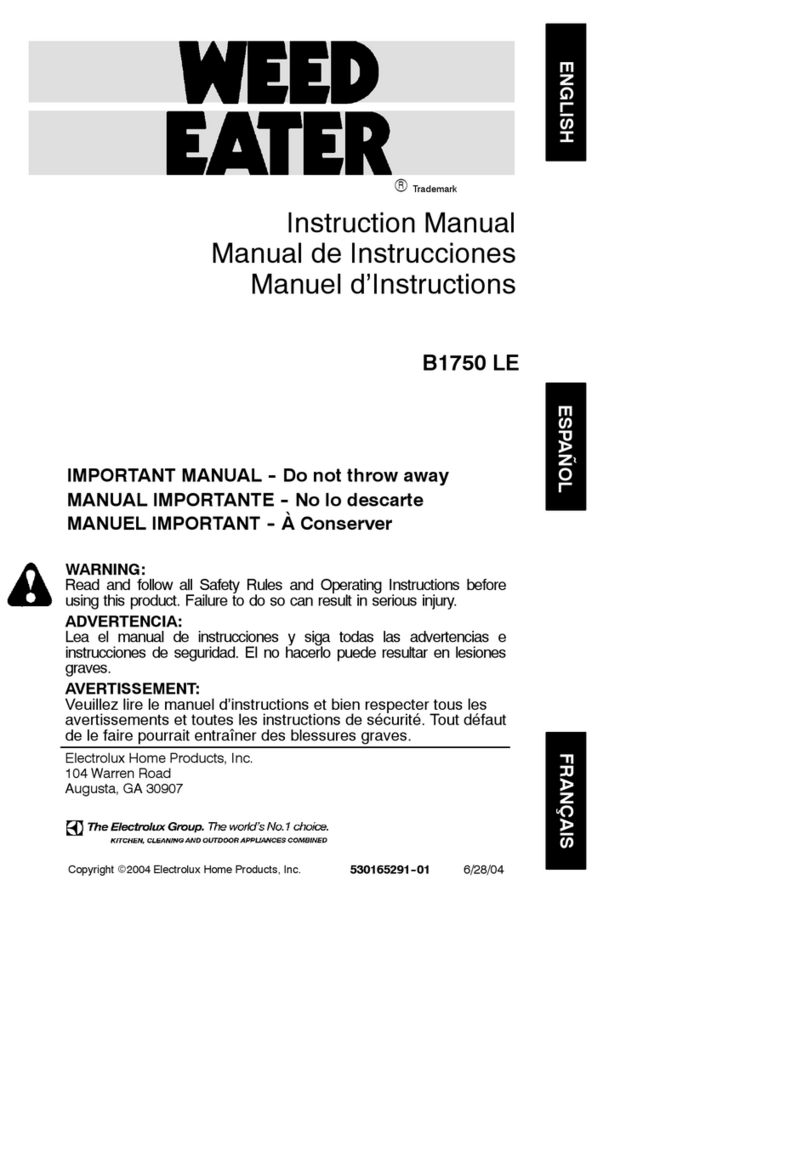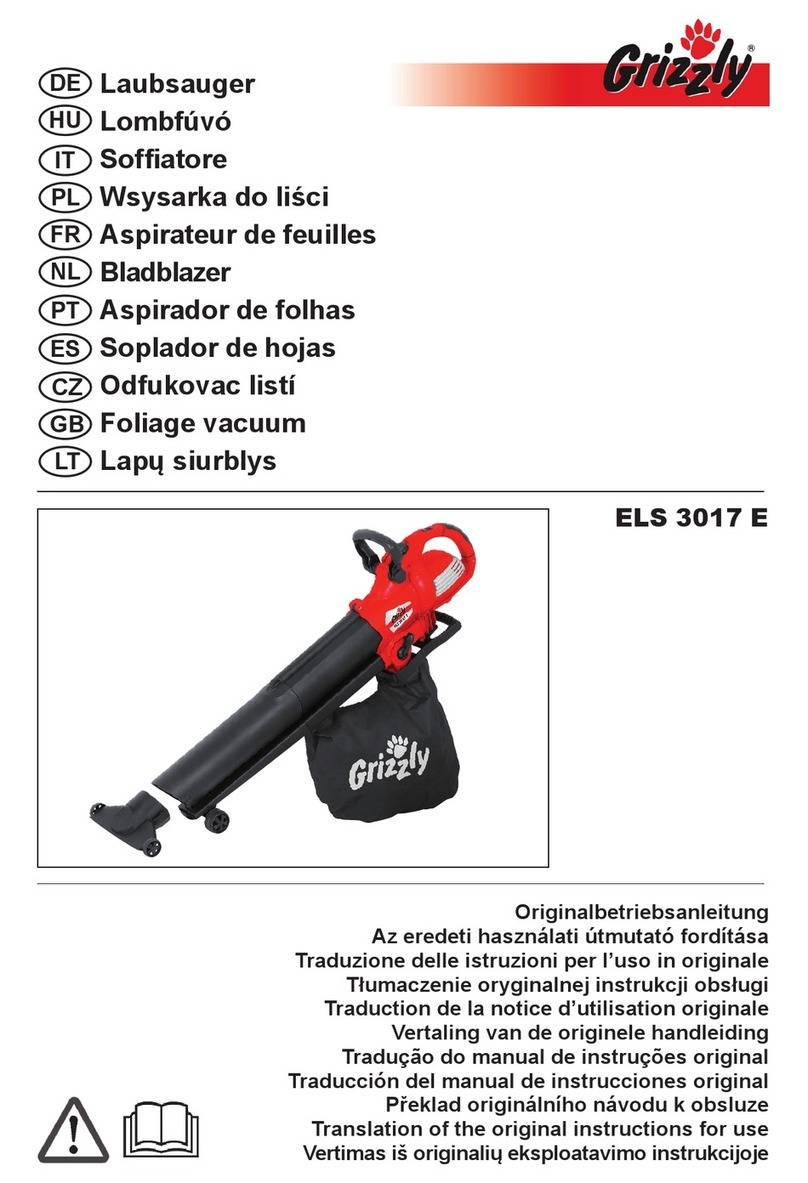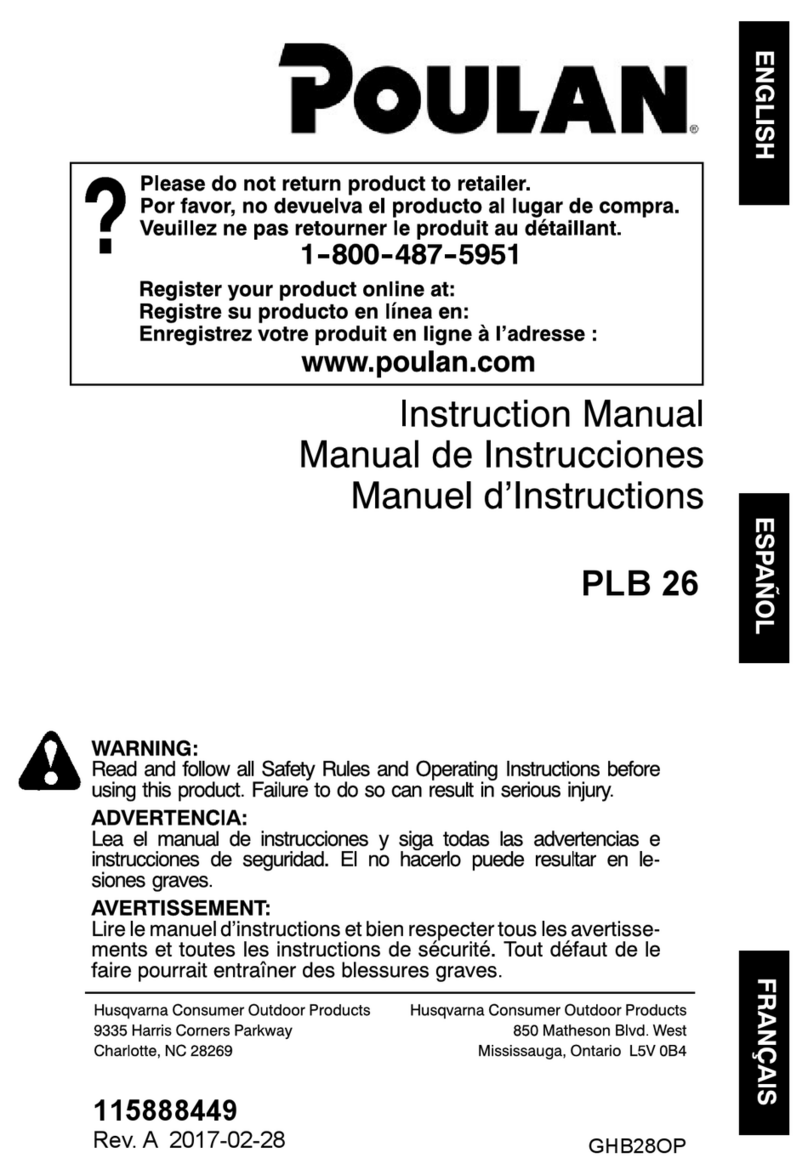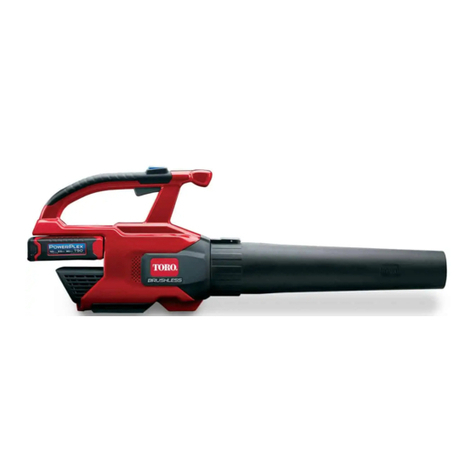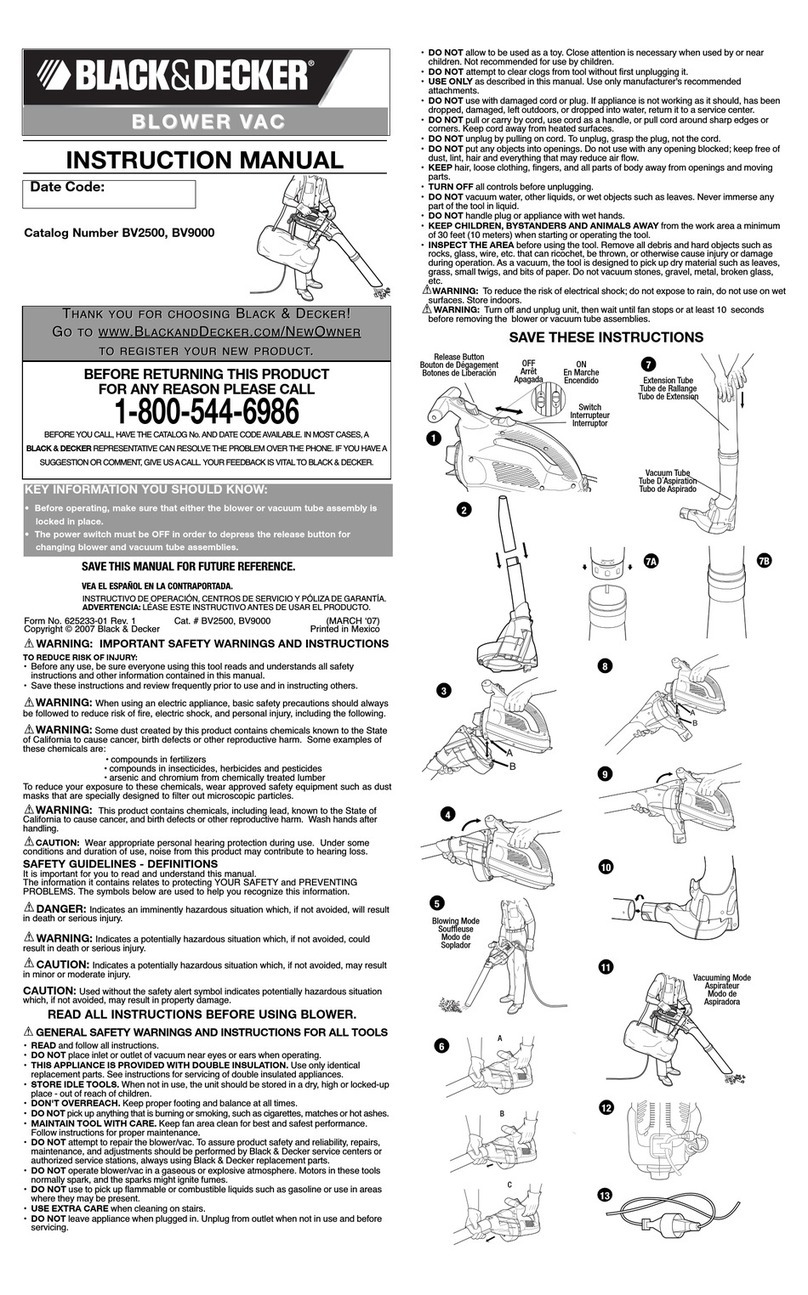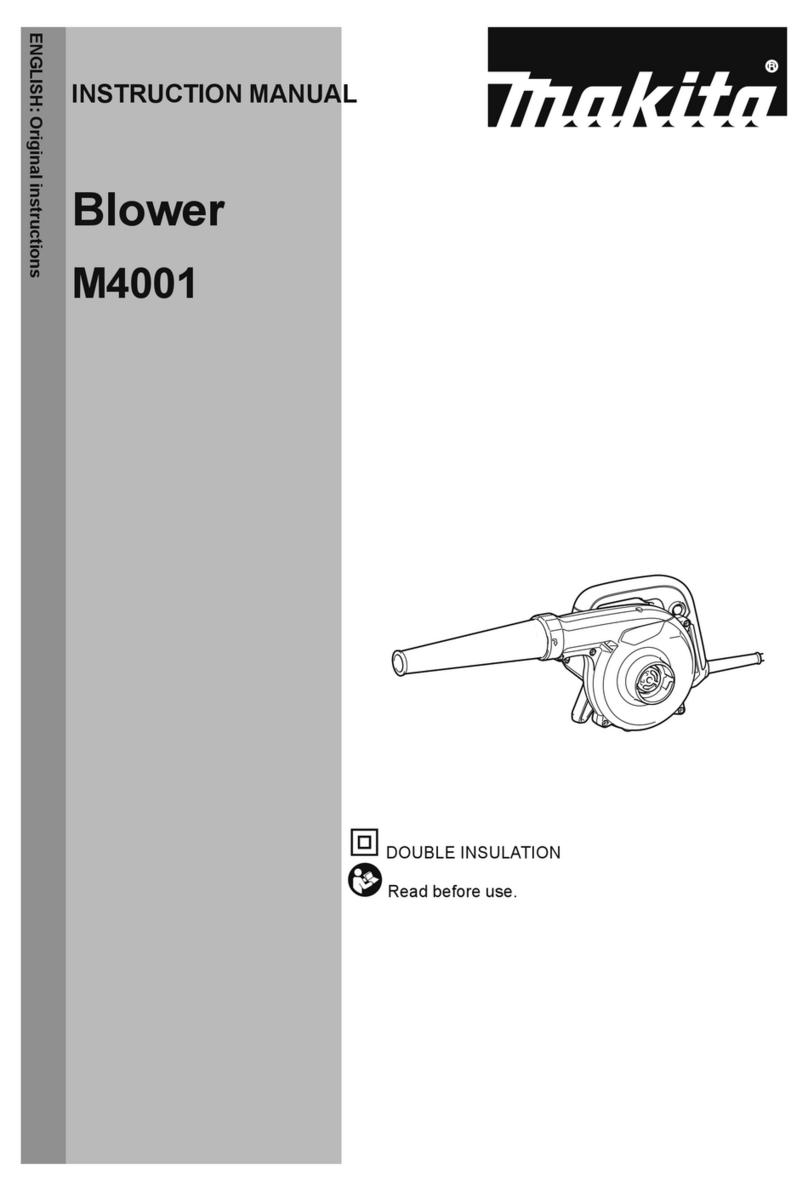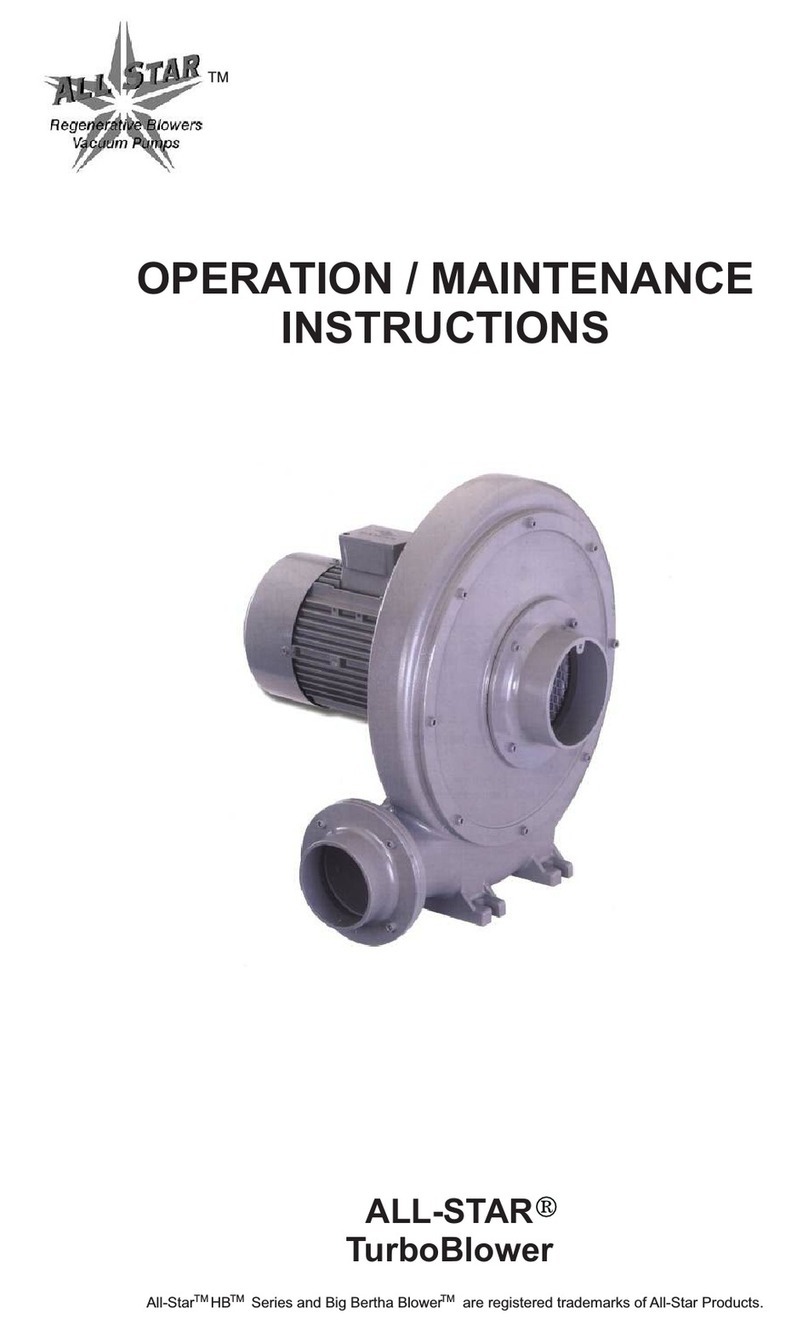Flex BW 18.0-EC User manual

BW 18.0-EC

=
Instruction manual ..................................................... 3
Notice d'utilisation.................................................... 14
Instrucciones de funcionamiento............................. 26

BW 18.0-EC Instruction manual
3
Contents
Meanings of signal words . . . . . . . . . . . . 3
Important safety informations . . . . . . . . . 3
GENERAL BATTERY-OPERATED
POWER TOOL SAFETY WARNINGS . . 4
SPECIFIC SAFETY RULES AND
SYMBOLS . . . . . . . . . . . . . . . . . . . . . . . . 6
Technical specifications . . . . . . . . . . . . . 7
Overview . . . . . . . . . . . . . . . . . . . . . . . . . 8
Operating instructions . . . . . . . . . . . . . . . 9
Maintenance and care . . . . . . . . . . . . . . 12
Warranty . . . . . . . . . . . . . . . . . . . . . . . . 12
Meanings of signal words
WARNING
WARNING indicates a potentially
hazardous situations which, if ignored,
could result in death or serious injury.
CAUTION
CAUTION indicates a potentially hazardous
situations which, if not avoided, may result
in minor or moderate injury, or may cause
machine damage.
NOTE
NOTE emphasizes essential information.
Important safety informations
Read and understand all of the safety
precautions, warnings and operating
instructions in the Instruction manual before
operating or maintaining this power tool.
Most accidents that result from power tool
operation and maintenance are caused by
the failure to observe basic safety rules or
precautions.
An accident can often be avoided by
recognizing a potentially hazardous
situation before it occurs, and by observing
appropriate safety procedures.
Basic safety precautions are outlined in the
“SAFETY” section of this Instruction manual
and in the sections which contain the
operation and maintenance instructions.
Hazards that must be avoided to prevent
bodily injury or machine damage are
identified by WARNINGS on the power tool
and in this Instruction manual.
NEVER use this power tool in a manner that
has not been specifically recommended by
FLEX.
Intended use
This battery operated blower BW 18.0-EC is
designed
Ófor use in household,
ÓHousehold type. Store indoors.
Not permitted are
ÓAir sweeping hot, combustible or
explosive materials.
ÓAir sweeping dust containing hazardous
substances (e.g. hardwood flour or quartz
in concrete dust) or classified as
hazardous material.

Instruction manual BW 18.0-EC
4
GENERAL BATTERY-OPERATED POWER TOOL
SAFETY WARNINGS
==WARNING:
Read all safety warnings, instructions, illustrations and
specifications provided with this power tool.
Failure to follow all instructions listed below may result in electric
shock, fire and/or serious injury.
Save all warnings and instructions for future reference.
The term “power tool” in all of the warnings refers to your mains-operated
(corded) power tool or battery-operated (cordless) power tool.
1. Work area safety
(a) Keep work area clean and well lit.
Cluttered and dark areas invite accidents.
(b) Do not operate power tools in explosive
atmospheres, such as in the presence of
flammable liquids, gases or dust.
Power tools create sparks which may ignite
the dust or fumes.
(c) Keep children and bystanders away
while operating a power tool.
Distractions can cause you to lose control.
2. Electrical safety
(a) Do not expose power tools to rain or wet
conditions.
Water entering a power tool will increase
the risk of electric shock.
3. Personal safety
(a) Stay alert, watch what you are doing and
use common sense when operating a
power tool. Do not use a power tool while
you are tired or under the influence of drugs,
alcohol or medication.
A moment of inattention while operating
power tools may result in serious personal
injury.
(b)
Always use personal protective equipment.
Personal protective equipment such as eye
protection, dust mask, non-skid safety
shoes, hard hat and/or hearing protection
used for appropriate conditions will reduce
personal injuries.
(c) Prevent unintentional starting.
Ensure the switch is in the off-position
before connecting to power source and/or
battery pack, picking up or carrying the tool.
Carrying power tools with your finger on the
switch or energizing power tools that have
the switch on invites accidents.
(d) Remove any adjusting key or wrench
before turning the power tool on. A wrench
or a key left attached to a rotating part of the
power tool may result in personal injury.
(e) Do not overreach. Keep proper footing
and balance at all times. This enables better
control of the power tool in unexpected
situations.
(f) Dress properly. Do not wear loose
clothing or jewellery. Keep your hair,
clothing and gloves away from moving
parts. Loose clothes, jewellery or long hair
can be caught in moving parts.
(g) If devices are provided for the connec-
tion of dust extraction and collection
facilities, ensure these are connected and
properly used. Use of dust collection can
reduce dust-related hazards.
(h) Do not let familiarity gained from frequent
use of tools allow you to become complacent
and ignore tool safety principles.
A careless action can cause severe injury
within a fraction of a second.
4. Power tool use and care
(a) Do not force the power tool. Use the
correct power tool for your application.
The correct power tool will do the job better
and safer at the rate for which it was designed.

BW 18.0-EC Instruction manual
5
(b) Do not use the power tool if the switch
does not turn it on and off. Any power tool
that cannot be controlled with the switch is
dangerous and must be repaired.
(c) Remove the battery pack, if detachable,
from the power tool and/or activate any
battery disabling device before clearing
jammed material, making any adjustments,
changing accessories, cleaning, or storing
power tools. Such preventive safety
measures reduce the risk of starting the
power tool accidentally.
(d) Store idle power tools out of the reach of
children and do not allow persons unfamiliar
with the power tool or these instructions to
operate the power tool. Power tools are
dangerous in the hands of untrained users.
(e) Maintain power tools. Check for
misalignment or binding of moving parts,
breakage of parts and any other condition
that may affect the power tools operation.
If damaged, have the power tool repaired
before use. Many accidents are caused by
poorly maintained power tools and
accessories.
(f) Keep cutting tools sharp and clean.
Properly maintained cutting tools with sharp
cutting edges are less likely to bind and are
easier to control.
(g) Use the power tool, accessories and tool
bits etc. in accordance with these
instructions, taking into account the working
conditions and the work to be performed.
Use of the power tool for operations
different from those intended could result in
a hazardous situation.
(h) Keep handles and grasping surfaces
dry, clean and free from oil and grease.
Slippery handles and grasping surfaces
may lead to unsafe handling and/or loss
of control of the tool.
(i) Keep cables away from the working area
of the tool. During operation cables may be
hidden from view and can be accidentally
damaged by the tool.
5. Battery tool use and care
(a) Recharge only with the charger specified
by the manufacturer. A charger that is
suitable for one type of battery pack may
create a risk of fire when used with another
battery pack.
(b) Use power tools only with specifically
designated battery packs. Use of any other
battery packs may create a risk of injury and
fire.
(c) When battery pack is not in use, keep it
away from other metal objects, like paper
clips, coins, keys, nails, screws or other
small metal objects, that can make a
connection from one terminal to another.
Shorting the battery terminals together may
cause burns or a fire.
(d) Under abusive conditions, liquid may be
ejected from the battery; avoid contact.
If contact accidentally occurs, flush with
water. If liquid contacts eyes, additionally
seek medical help. Liquid ejected from the
battery may cause irritation or burns.
(e) Do not use a battery pack or tool that is
damaged or modified.
Damaged or modified batteries may exhibit
unpredictable behaviour resulting in fire,
explosion or risk of injury.
(f) Do not expose a battery pack or tool to
fire or excessive temperature.
Exposure to fire or temperature above
265 °F may cause explosion.
(g) Follow all charging instructions and do
not charge the battery pack or tool outside
the temperature range specified in the
instructions.
Charging improperly or at temperatures
outside the specified range may damage
the battery and increase the risk of fire.
6. Service
(a) Have your power tool serviced by a
qualified repair person using only identical
replacement parts. This will ensure that the
safety of the power tool is maintained.
(b) Never service damaged battery packs.
Service of battery packs should only be
performed by the manufacturer or authorized
service providers. Do not modify or attempt to
repair the appliance or the battery pack
(as applicable) except as indicated in the
instructions for use and care.

Instruction manual BW 18.0-EC
6
SPECIFIC SAFETY RULES AND SYMBOLS
1. Safety Warnings Common for
Blowing Operations
(a) This power tool is intended to function
as a blower. Read all safety warnings,
instructions, illustrations and specifications
provided with this power tool.
Failure to follow all instructions listed below
may result in electric shock, fire and/or
serious injury.
(b) Ensure that no persons in the vicinity are
injured by foreign particles that are swept up
into the air.
(c) Keep fingers away from the openings of
the power tool during use. Only operate the
blower with the nozzle attached.
The rotating blower can cause injuries.
(d) Do not air sweep substances that are
hazardous to health, such as beechwood
dust or oak dust, stone dust, asbestos.
These substances have been found to be
carcinogenic.
(e) Do not air sweep liquids. Any ingress of
liquid increases the risk of electric shock.
(f) Do not expose the device to rain or wet
conditions. The ingress of water in the motor
increases the risk of electric shock.
(g) Ensure that the workplace is well
ventilated.
(h) Wear additional personal protective
equipment such as safety goggles and
respirator (or breathing protection).
Wearing suitable protective equipment for
the conditions reduces any exposure to
hazardous substances.
(i) Do not allow to be used as toy.
(j) Use extra care when cleaning on stairs.
(k) Keep hair, loose clothing, fingers, and all
parts of body away from openings and
moving parts.
2. Additional Warnings
(a) The mains voltage and the voltage
specifications on the rating plate must
correspond.
(b) Only FLEX AUTHORIZED SERVICE
CENTER should disassemble or assemble
this power tool, and only genuine FLEX
replacement parts should be installed.
(c) Clean the exterior of the power tool only
with a soft cloth moistened with soapy
water, and dry thoroughly.
(d) Never use solvents, gasoline or thinners
on plastic components; otherwise the
plastic may dissolve.
3. Definitions for symbols used on
this tool
SAVE THESE INSTRUCTIONS AND MAKE THEM AVAILABLE
TO OTHER USERS AND OWNERS OF THIS TOOL!
Vvolts
r.p.m. Rotation rate
Before switching on the power
tool, read the operating manual!
Wear eye protection!
Wear ear protection!
Do not use in the rain or leave
outdoors while it is raining!
Keep bystanders away!

BW 18.0-EC Instruction manual
7
Technical specifications
BW 18.0-EC
Machine type Battery operated blower
Operating voltage V 18
Battery Ah 2.5
5.0
Weight of battery
ÓAP 18.0/2.5-US
ÓAP 18.0/5.0-US
kg
kg
0.42
0.72
Battery charger CA 10.8/18.0-US
Input voltage V~/Hz 120/60
Charging voltage V– 10.8/18.0
Charging time (depending on charge state)
ÓAP 18.0/2.5-US
ÓAP 18.0/5.0-US
min
min 40
45
Operating temperature °F 41 - 104
Weight (without battery) kg 0.89
Protection class ff=L=

Instruction manual BW 18.0-EC
8
Overview
1 Handle
2 ON/OFF switch
3 Lock button
4 Air volume regulator, 3 stage
5 Air inlet
6 Bayonet connection
7Nozzle
8 Reducing nozzles
9 Adapter
10 Slot for battery
11 Li-ion battery
12 Release button for battery
13 State of charge indicator

BW 18.0-EC Instruction manual
9
Operating instructions
WARNING
Risk of electric shock! Before carrying out
any work on the power tool, always remove
the battery.
Before switching on the power
tool
Unpack the power tool and check that there
are no missing or damaged parts.
NOTE
The batteries are not fully charged on
delivery. Prior to initial operation, charge
the batteries fully. Refer to the charger
operating manual.
Inserting/replacing the battery
1. Press the charged battery into the
power tool until it clicks into place.
2. To remove, press the release button (1.)
and pull out the battery (2.).
CAUTION
When the device is not in use, protect the
battery contacts. Loose metal parts may
short-circuit the contacts; explosion and fire
hazard!
Battery state of charge
1. Press the button to check the state of
charge at the state of charge indicator
LEDs.
The indicator goes out after 5 seconds.
If one of the LEDs flashes, the battery must
be recharged. If none of the LEDs light up
after the button is pressed, the battery is
faulty and must be replaced.
Attaching the nozzle
Attaching
1. Attach the nozzle to the bayonet
connection by turning lightly in anti-
clockwise direction.
2. Check that the adapter is securely
seated!
Detaching
1. Remove in reverse order.

Instruction manual BW 18.0-EC
10
Attaching the reducing nozzles
Mounting on the bayonet connection
1. Attach the adaptor to the bayonet
connection by turning lightly in anti-
clockwise direction.
2. Check that the adapter is securely
seated.
3. Fit the relevant reducing nozzle.
Detaching
1. Remove in reverse order.
Mounting on the air inlet
NOTE
The adapter is mounted on the air inlet to
extract air.
1. Fit the adapter on the air inlet.
2. Fit the relevant reducing nozzle.
Detaching
1. Remove in reverse order.
Switching on and off
CAUTION
ÓNever direct the nozzle of the power tool
at other persons or yourself.
ÓUse personal protective equipment:
safety goggles, ear defenders and also
a respirator (or breathing protection) if
dust is agitated during operation of the
power tool. It is also recommended to
wear suitable footwear, long trousers and
gloves while working with the power tool.
ÓKeep hair and clothing away from
openings and moving parts.
Brief operation without engaged
switch rocker
1. Press and hold down the switch.
2. To switch off, release the switch.
Continuous operation with engaged
switch rocker
1. Press and hold down the switch (1.).
2. To lock into position, hold down the
locking button and release the switch (2.).

BW 18.0-EC Instruction manual
11
3. To switch off, briefly press and release
the switch.
Preselecting the speed
The speed can be preselected in 3 stages
between 10,600 and 18,000 rpm.
Operating informations
CAUTION
When it is switched off, the blower continues
to run briefly.
Air sweeping
1. Fit the nozzle.
2. Insert battery.
3. Set the speed to the required setting.
4. Hold the power tool with one hand on
the handle and assume the working
position.
5. Switch on thepower tool.
At the end of work:
6. Release the switch.
Inflating
1. Fit the adapter with suitable reducing
nozzle on the bayonet connection.
2. Insert battery.
3. Attach the reducing nozzle, ensuring
an exact fit.
4. Set the speed to the required setting.
5. Hold the power tool with one hand on
the handle and assume the working
position.
6. Switch on thepower tool.
At the end of work:
7. Release the switch.

Instruction manual BW 18.0-EC
12
Deflating
1. Fit the adapter with suitable reducing
nozzle on the air inlet.
2. Insert battery.
3. Attach the reducing nozzle, ensuring an
exact fit.
4. Set the speed to the required setting.
5. Hold the power tool with one hand on the
handle and assume the working position.
6. Switch on thepower tool.
At the end of work:
7. Release the switch.
Maintenance and care
WARNING
Risk of electric shock! Before carrying out
any work on the power tool, always remove
the battery.
Cleaning
Electric power tool
WARNING
Do not use water or liquid detergents.
1. Regularly blow out the housing interior
and motor with dry compressed air.
Repairs
Repairs may be carried out by an authorised
customer service centre only.
Spare parts and accessories
NOTE
Only the tools released by FLEX may be used.
Other accessories, in particular insertion
tools, can be found in the manufacturer’s
catalogues.
Exploded drawings and spare-part lists can
be found on our homepage:
www.flex-tools.com
Warranty
FLEX North America limited one
year Warranty
FLEX North America warrants its Profes-
sional Power Tools for a period of one year
from the date of original purchase. We will
repair or replace at our option, any part or
parts of the product and accessories covered
under this warranty, which, after examination,
prove(s) to be defective in workmanship or
material during the warranty period. For repair
or replacement, return the complete tool or
accessory, transportation prepaid, to your
nearest Authorized Service Station.
Proof of purchase may be required.
Thiswarranty does not apply to repair or
replacement due to misuse, abuse, normal
wear and tear or repairs attempted or made by
someone other than our Authorized Service
Stations.
ANY IMPLIED WARRANTY, INCLUDING
THE IMPLIED WARRANTIES OF
MERCHANTABILITY AND FITNESS FOR
PARTICULAR PURPOSE, WILL LAST
ONLY FOR ONE (1) YEAR FROM THE
DATE OF PURCHASE.
To obtain information on warranty perfor-
mance, please write to:
FLEX - North America, Inc.
2720 E. Phillips Road
Greer, SC 29650, U.S.A.
1-877-331-6103 (main line)
1-888-331-6104 (fax line)
www.FlexNorthAmerica.com

BW 18.0-EC Instruction manual
13
THE FOREGOING OBLIGATION IS FLEX
NORTH AMERICA'S SOLE LIABILITY
UNDER THIS OR ANY IMPLIED WARRAN-
TY AND UNDER NO CIRCUMSTANCES
SHALL FLEX NORTH AMERICA BE
LIABLE FOR ANY INCIDENTAL OF
CONSEQUENTIAL DAMAGES.
Some states do not allow limitations on how
long an implied warranty lasts or the
exclusion or limitation of incidental or
consequential damages, so the above
limitation or exclusion may not apply to you.
This warranty gives you specific legal rights
and you may also have other legal rights,
which vary from state to state.

Notice d’utilisation BW 18.0-EC
14
Sommaire
Symboles utilisés . . . . . . . . . . . . . . . . . . 14
Informations de sécurité importantes . . 14
RÈGLES DE SÉCURITÉ GÉNÉRALES
POUR TOUS LES OUTILS ALIMENTÉS
PAR BATTERIE . . . . . . . . . . . . . . . . . . 15
RÈGLES SPÉCIFIQUES DE SÉCURITÉ
ET SYMBOLES . . . . . . . . . . . . . . . . . . . 18
Caractéristiques techniques . . . . . . . . . 19
Vue d’ensemble . . . . . . . . . . . . . . . . . . . 20
Mode d'emploi . . . . . . . . . . . . . . . . . . . . 21
Entretien et nettoyage . . . . . . . . . . . . . . 24
Garantie . . . . . . . . . . . . . . . . . . . . . . . . . 24
Symboles utilisés
AVERTISSEMENT
Un texte précédé du terme
AVERTISSEMENT signale une situation
potentiellement dangereuse qui, si vous
n’en tenez pas compte, s’assortit d’un
danger de mort ou de blessures graves.
MISE EN GARDE
Un texte précédé du terme MISE EN GARDE
signale une situation potentiellement
dangereuse qui, si vous n’en tenez pas
compte, s’assortit d’un risque de blessure
mineure ou modérée, ou d’endommagement
de la machine.
REMARQUE
Le terme REMARQUE met en évidence des
informations essentielles.
Informations de sécurité
importantes
Avant d’utiliser ou d’entretenir cet outil
électroportatif, veuillez lire et bien assimiler
tous les textes sur les précautions de sécurité,
les avertissements et les instructions
d’utilisation de la présente notice d’utilisation.
La plupart des accidents provoqués par des
outils électroportatifs en fonctionnement et
lors de leur maintenance sont dus à des
règles ou précautions de sécurité de base
qui n’ont pas été respectées.
Il est souvent possible d’éviter un accident
en anticipant une situation potentiellement
dangereuse avant même qu’elle
n’apparaisse, et en respectant les
procédures de sécurité appropriées.
Les précautions de sécurité de base à prendre
sont décrites au chapitre « SÉCURITÉ » de
cette notice d’utilisation et aux chapitres
contenant les instructions d’utilisation et de
maintenance.
Les risques à éviter pour éviter des dommages
corporels et d’endommager la machine sont
identifiés par des mentions d’AVERTISSEMENT
sur l’outil électroportatif et dans la présente
notice d’utilisation.
N’utilisez JAMAIS cet outil électroportatif
d’une façon qui n’a pas été spécifiquement
recommandée par FLEX.
Conformité d’utilisation
Ce souffleur sans fil BW 18.0-EC est conçu
Ópour un usage domestique,
ÓAppareil à usage domestique. Entreposer
à l'intérieur.
Ne sont pas autorisés
Óle balayage d’air de matériaux chauds,
inflammables ou explosifs.
Óle balayage d’air contenant des
substances dangereuses (p. ex., farine
de bois dur ou quartz dans la poussière
de béton) ou classées comme matières
dangereuses.

BW 18.0-EC Notice d’utilisation
15
RÈGLES DE SÉCURITÉ GÉNÉRALES POUR TOUS LES
OUTILS ALIMENTÉS PAR BATTERIE
AVERTISSEMENT :
Veuillez lire toutes les consignes de sécurité,
instructions, illustrations et spécifications fournies avec cet appareil
électroportatif.
Si vous ne respectez pas les instructions qui suivent, vous risquez une
électrocution, de provoquer un incendie et/ou des blessures graves.
Veuillez conserver toutes les consignes de sécurité et instructions
dans un endroit sûr pour pouvoir les reconsulter ultérieurement.
La notion d’ « outil électroportatif » mentionnée par la suite se rapporte à des
outils électriques raccordés au secteur (avec câble de raccordement) et à des
outils électriques à batterie (sans câble de raccordement).
1. Sécurité de l’aire de travail
(a) Maintenez l’aire de travail propre et bien
éclairé.
Les établis encombrés et les aires de travail
sombres ouvrent la porte aux accidents.
(b) N’utilisez pas les outils électriques dans
les atmosphères explosives, par exemple
en présence de liquides, gaz ou poussières
inflammables.
Les outils électroportatifs produisent des
étincelles au contact desquelles la poussière
ou les vapeurs peuvent s’enflammer.
(c) Tenez à distance les curieux et les
enfants pendant que vous travaillez avec
un outil électroportatif.
Ils pourraient vous distraire et vous faire
perdre la maîtrise de l’outil.
2. Sécurité en matière d’électricité
(a) N’exposez pas l’outil électroportatif
à la pluie ou à l’humidité.
L’eau qui pénètre dans un outil électroportatif
augmente le risque d’électrocution.
3. Sécurité des personnes
(a) Restez alerte, attentif à vos gestes,
et faites preuve de bon sens lorsque vous
utilisez un outil électrique. Évitez d’utiliser
l’outil lorsque vous êtes fatigué ou sous
l’influence de drogues, d’alcool ou de
médicaments.
Tout moment d’inattention pendant
l’utilisation d’un outil électrique comporte un
risque de blessure grave.
(b) Utilisez des accessoires de sécurité.
Des accessoires de sécurité, tels que
masque anti-poussière, bottes de sécurité
antidérapantes, casque de protection ou
protection acoustique, utilisés en fonction
du travail à effectuer, réduisent le risque
de blessure.
(c) Prévenez tout démarrage accidentel.
Assurez-vous que l’interrupteur est en
positon d’arrêt avant de brancher l’outil et/
ou d’insérer le bloc-piles, de soulever ou de
transporter l’outil.
En transportant l’outil avec le doigt sur
l’interrupteur ou en insérant le bloc-piles
alors que l’interrupteur est en position de
marche, vous ouvrez toute grande la porte
aux accidents.

Notice d’utilisation BW 18.0-EC
16
(d) Enlevez les clés de réglage ou de
serrage avant de démarrer l’outil. Une clé
laissée dans une pièce tournante de l’outil
peut provoquer des blessures.
(e) Ne vous penchez pas trop en avant.
Maintenez un bon appui et restez en
équilibre en tout temps. Une bonne stabilité
vous permet de mieux réagir à une situation
inattendue.
(f) Portez des vêtements appropriés.
Ne portez pas de vêtements amples ni de
bijoux. N’approchez jamais les cheveux,
les vêtements ou les gants des pièces en
mouvement. Des vêtements amples, des
bijoux ou des cheveux longs peuvent être
happés par des pièces en mouvement.
(g) Si des dispositifs servant à aspirer ou
à recueillir les poussières doivent être
utilisés, vérifiez que ceux-ci soient
effectivement raccordés et qu’ils sont
correctement utilisés. L’utilisation de tels
dispositifs réduit les dangers dus aux
poussières.
(h) Ne vous laissez pas tromper (au fil d’une
utilisation répétée) par un sentiment de
familiarité avec l’outil, en négligeant le respect
des consignes de sécurité.
Une manœuvre imprudente peut causer
des blessures graves en une fraction de
seconde.
4. Utilisation et entretien de l’outil
électroportatif
(a) Ne forcez pas l’outil. Utilisez un outil
électroportatif qui convient au travail à
effectuer. Si vous utilisez le bon outil et
respectez le régime
pour lequel il a été conçu, il effectuera un
travail de meilleure qualité et de façon plus
sûre.
(b) N’utilisez pas un outil électroportatif
si son interrupteur est bloqué. Un outil que
vous ne pouvez pas commander par son
interrupteur est dangereux et doit être
réparé.
(c) Retirez le bloc-piles de l’outil ou placez
l’interrupteur en position de verrouillage ou
d’arrêt avant d’effectuer tout réglage, de
changer d’accessoire ou de ranger l’outil.
De telles mesures préventives réduisent les
risques de démarrage accidentel de l’outil.
(d) Une fois l’utilisation de l’outil terminée,
rangez-le hors de portée des enfants et des
personnes qui en ignorent le
fonctionnement. Les outils représentent un
danger entre les mains de personnes qui
n’en connaissent pas le mode d’utilisation.
(e) Entretien des outils électroportatifs.
Vérifiez que les pièces mobiles ne sont pas
désalignées ou coincées, qu’aucune pièce
n’est cassée et que l’outil n’a subi aucun
dommage affectant son bon
fonctionnement. Le cas échéant, faites
réparer l’outil avant de l’utiliser. De
nombreux accidents sont causés par des
outils mal entretenus.
(f) Les outils de coupe doivent être toujours
bien affûtés et propres. Des outils bien
entretenus, dont les arêtes sont bien
tranchantes, sont moins susceptibles de
coincer et plus faciles à diriger.
(g) Suivez ces instructions pour utiliser
l’outil, les accessoires, les embouts, etc. en
tenant compte aussi bien des conditions de
travail que du travail à effectuer. L’utilisation
de l’outil électroportatif pour des tâches
autres que celles pour lesquelles il est
destiné pourrait créer une situation
dangereuse.
(h) Conserver les poignées et les surfaces
de préhension sèches, propres et exemptes
d’huile et de graisse. Des poignées et des
surfaces de préhension glissantes peuvent
entraîner une manipulation dangereuse ou
la perte de maîtrise de l’outil.
(i) Maintenir les câbles éloignés de l’aire
de travail de l’outil. Pendant son
fonctionnement, des câbles peuvent être
dissimulés et l’outil peut accidentellement
les endommager.
5. Utilisation des outils fonctionnant
sur batteries et précautions
d’emploi
(a) Se servir uniquement du chargeur
spécifié par le fabricant. L’utilisation d’un
chargeur conçu pour un type donné de
batterie peut comporter un risque d’incendie
avec un autre type de batterie.

BW 18.0-EC Notice d’utilisation
17
(b) En utilisant un outil alimenté par batterie,
servez-vous uniquement du bloc-piles
spécialement conçu à cet effet. L’emploi
d’autres batteries risquerait de provoquer
un risque d’incendie.
(c) Lorsque vous n’utilisez pas le bloc-piles,
rangez-le à l’écart des objets tels que les
trombones, pièces de monnaie, clés, clous,
vis et autres petits objets métalliques qui
risquent d’établir la connexion entre les
bornes. Il y a risque d’étincelles, de brûlures
et d’incendie si les bornes de la batterie sont
court-circuitées.
(d) Dans de mauvaises conditions, du
liquide peut être éjecté de la batterie; évitez
tout contact. En cas de contact accidentel,
rincez à l’eau claire. Si le liquide entre en
contact avec les yeux, consultez un
médecin. Le liquide éjecté des batteries
peut causer des irritations ou des brûlures.
(e) N’utilisez pas un bloc-piles ou un outil
endommagé ou modifié.
Les batteries endommagées ou modifiées
peuvent avoir un comportement
imprévisible et provoquer un incendie, une
explosion ou un risque de blessure.
(f) Ne pas exposer un bloc-piles ou un outil
fonctionnant sur batteries au feu ou à une
température excessive.
Une exposition au feu ou à une température
supérieure à 130 °C peut provoquer une
explosion.
(g) Suivre toutes les instructions de charge
et ne pas charger le bloc de batteries ou
l’outil fonctionnant sur batteries hors de la
plage de températures spécifiée dans les
instructions.
Un chargement incorrect ou à des
températures hors de la plage spécifiée de
températures peut endommager la batterie
et augmenter le risque d’incendie.
6. Service
(a) Les réparations doivent être confiées
à un technicien qualifié, utilisant
exclusivement des pièces de rechange
identiques à celles d’origine. Ceci assurera
le maintien de la sécurité de l’outil
électroportatif.
(b) N’effectuez jamais d’opération d’entretien
sur des blocs de batteries endommagés.
L’entretien des blocs-piles ne devrait être
effectué que par le fabricant ou les
fournisseurs de service autorisés. Ne modifiez
pas et ne tentez pas de réparer l’appareil ou le
bloc-piles (selon le cas), sauf dans la mesure
indiquée dans les instructions d’utilisation et
d’entretien.

Notice d’utilisation BW 18.0-EC
18
RÈGLES SPÉCIFIQUES DE SÉCURITÉ ET SYMBOLES
1. Consignes de sécurité
courantes pour les opérations
de soufflage
(a) Cet outil électroportatif est conçu pour
être utilisé comme un souffleur. Veuillez
respecter toutes les consignes de sécurité,
instructions, illustrations et spécifications
fournies avec cet outil électroportatif.
Si vous ne respectez pas les instructions qui
suivent, vous risquez une électrocution, de
provoquer un incendie et/ou des blessures
graves.
(b) Veillez à ce que les personnes se tenant
à proximité ne soient pas blessées par la
projection de corps étrangers.
(c) Gardez les doigts à distance des
ouvertures de l’outil électroportatif pendant
son fonctionnement. N’utilisez le souffleur
qu’avec la buse installée. Le ventilateur
rotatif peut provoquer des blessures.
(d) Ne soufflez pas sur des matières
présentant un risque pour la santé, comme
les poussières de hêtre et de chêne, la
poussière de roche ou l’amiante.
Ces matières sont jugées cancérigènes.
(e) Ne soufflez pas sur des liquides.
La présence de liquides à l’intérieur de
l’appareil accroît le risque de choc électrique.
(f) Gardez l’appareil à l’abri de la pluie et de
l’humidité. La présence d’eau à l’intérieur de
l’appareil accroît le risque de choc électrique.
(g) Veillez à la bonne ventilation de l’aire de
travail.
(h) Portez un équipement de protection
individuelle, avec notamment des lunettes
et un masque (ou une protection
respiratoire). Dans ces conditions, le port
d’un équipement de protection réduit
l’exposition aux substances dangereuses.
(i) Ne permettez pas que l'appareil soit
utilisé comme jouet.
(j) Soyez particulièrement prudent lorsque
vous nettoyez les escaliers.
(k) Tenir les cheveux, les vêtements
amples, les doigts et toutes les parties du
corps éloignés des ouvertures et des pièces
mobiles.
2. Autres consignes de sécurité
(a) La tension du secteur et celle indiquée sur
la plaque signalétique doivent concorder.
(b) Il ne faut confier qu’au CENTRE AGRÉÉ
DE SAV FLEX le démontage ou
l’assemblage de cet outil électroportatif, et
n’installer que des pièces de rechange
FLEX d’origine.
(c) Ne nettoyez les surfaces extérieures de
l’outil électroportatif qu’avec un chiffon doux
humecté d’un peu d’eau savonneuse, puis
séchez à fond.
(d) N’utilisez jamais de solvants, d’essence
ou de diluants sur les pièces en plastique,
car ils risquent de dissoudre le plastique.
3. Définitions des symboles
apposés sur cet outil
CONSERVEZ CES INSTRUCTIONS ET METTEZ-LES À LA
DISPOSITION DES AUTRES UTILISATEURS ET PROPRIÉTAIRES
DE CET OUTIL!
Vvolts
t/min nombre de tours par minute
Avant d’allumer l’outil
électroportatif, lisez la notice
d’utilisation!
Portez des lunettes de
protection!
Portez un casque anti-bruit!
Ne le laissez pas sous la pluie ou
à l’extérieur quand il pleut!
Tenez les curieux à l’écart!

BW 18.0-EC Notice d’utilisation
19
Caractéristiques techniques
BW 18.0-EC
Type d’appareil Souffleur à batterie
Tension nominale V 18
Batterie Ah 2,5
5,0
Poids de la batterie
ÓAP 18,0/2,5-US
ÓAP 18,0/5,0-US
kg
kg
0,42
0,72
Chargeur de batterie CA 10.8/18.0-US
Tension d’entrée V~/Hz 120/60
Tension de charge V– 10.8/18.0
Temps de charge (en fonction de l’état de
charge)
ÓAP 18.0/2,5-US
ÓAP 18.0/5,0-US min
min 40
45
Température de fonctionnement °C 5 - 40
Poids (sans batterie) kg 0,89
Classe de protection II /

Notice d’utilisation BW 18.0-EC
20
Vue d’ensemble
1 Poignée
2 Commutateur marche/arrêt
3 Bouton de verrouillage
4 Régulateur de débit d’air 3 positions
5 Entrée d’air
6 Raccord à baïonnette
7Buse
8 Buses de réduction
9 Adaptateur
10 Compartiment de la batterie
11 Batterie lithium-ion
12 Touche de déverrouillage de la
batterie
13 Voyant de niveau de la batterie
Other manuals for BW 18.0-EC
3
Table of contents
Languages:
Other Flex Blower manuals
